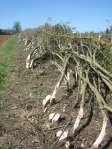Last February saw our third not quite annual hedge laying weekend attended by a group of mostly local people, some already well practised in the craft; others eager to learn.
It was a grim weekend of irregular snow flurries and bitter north-easterly wind but despite such unpleasantness, a dozen or so people turned out and we completed about 60 metres of wide, gappy and alarmingly prickly hedge.
It’s now May and the miracle that is a plant’s vascular system has struck again. Most of the stems attacked by axe, billhook and chainsaw in February continue to carry water and nutrients, they have burst into leaf and flowered with some enthusiasm.
Our hedge isn’t a picture of technique nor is it one to copy in next winter’s competitions. It is however the first I’ve worked on where function outweighs form. It will prevent our cattle from going west (towards Silsoe), so it’s laid to be thick and dense rather than beautiful. There’s more to do next winter; hope we haven’t put everyone off.
The image to the right shows the ‘back’ of the laid hedge; the side that will be cow-ward. I lay in the ‘Midland Bullock’ style which places each cut stem or ‘pleacher’ slightly behind the line of the hedge. This throws all the bushy, prickly tops to one side (the back) of the hedge forming, if it’s successful, an impenetrable barrier. It’s on this side ideally where the cattle hang out, unable to reach the fresh and tasty new shoots developing on the much more pretty and vulnerable ‘front’.





